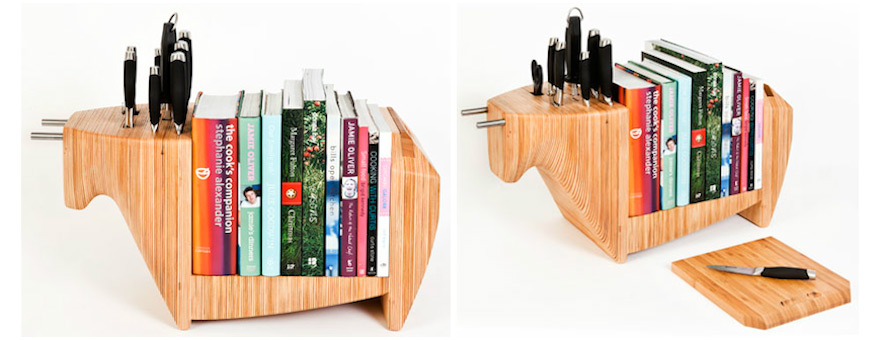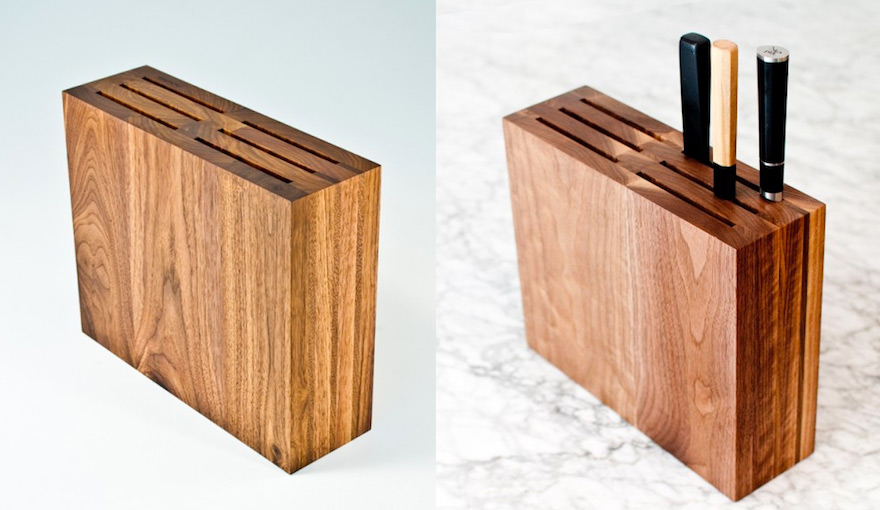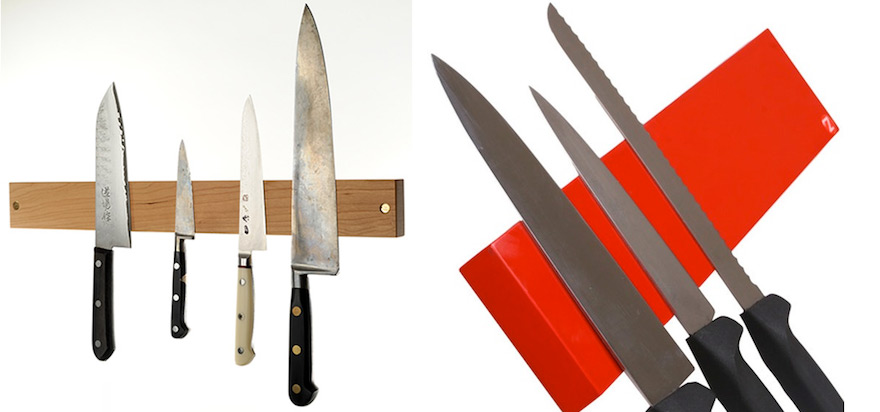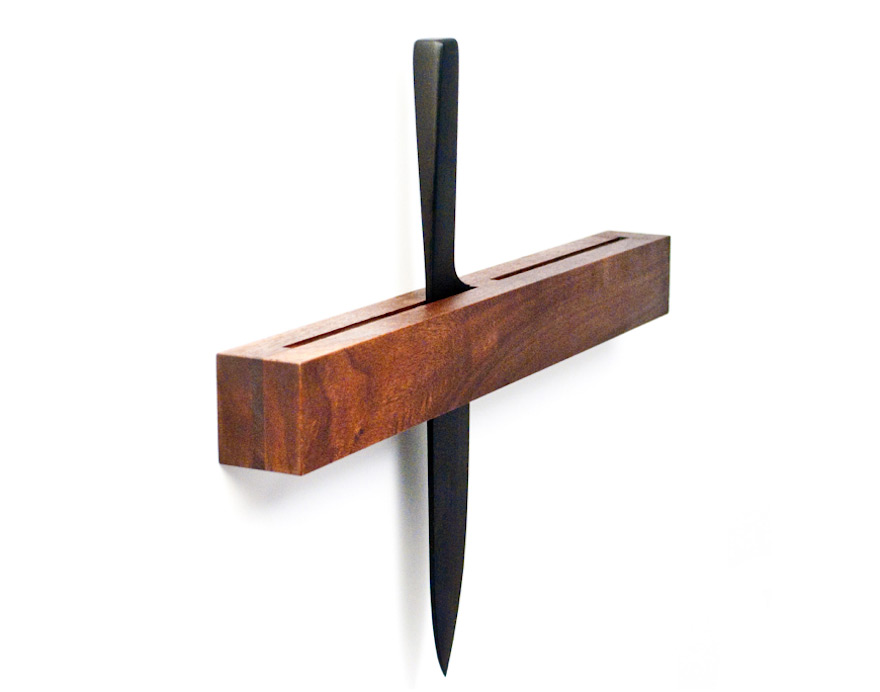Designing for Knife Storage, Part 1: Blocks and Wall Racks

When I work with clients to organize their kitchens, knife storage is one of the issues we tackle. Everyone has different needs and constraints—but fortunately, designers have given us numerous options to help meet those needs.

The Toro Legno (Kitchen Bull) shown above is a fanciful item: a knife block with 10 slots, a book shelf and a cheese board. For those with the necessary countertop space, it could be a great way to keep multiple items close at hand—and that cheese board could perhaps serve as a cutting board, something most people are more likely to need quick access to. The Toro Legno is made from renewable plantation pine, which may appeal to end-users with ecological concerns.

But let's back up a minute, and start with the basics. The slanted, slotted knife block, so commonly used, has numerous advantages: It can store a lot of knives, it makes them easy to grab, and it will usually fit under the upper cabinets. Such blocks also tend to be heavy enough, with a low enough center of gravity, that they are unlikely to fall over. One disadvantage is the slots may not match the knives the end-user has, unless the knives were bought from the same manufacturer. Looking at knife blocks from some top name brands, you'll see some variations. The 25-slot knife block from Wüsthof has rubberized feet to help keep it in position. The one from Henckels, on the right, uses horizontal rather than vertical slots for the steak knives, in order to allow the handles on all the company's cutlery to fit.

You can take the same basic design and give it a very different look, as Wüsthof does with this knife block.

Moving mostly away from the traditional slanted look, Michael Bras makes these two 2-piece knife blocks, in Corian and in maple; they're designed to be sculptural art as well as kitchen tools. These blocks are specifically designed to fit his knives; a nice touch is that the slots are numbered, so you always know which slot holds which knife. The use of Corian is interesting. It's nonporous, so it won't stain. It's also easy to clean; you just need to remember not to use abrasives on it. However, as someone who has dark blue Corian countertops in her bathroom, with white sink basins, I can confirm DuPont's cautionary note that the darker colors show minor scratches more readily than lighter colors do.

Some designers have totally forsaken the slanted design, and have gone with a straight vertical approach. This is a less clunky look, and saves space — but it potentially loses some of the other benefits listed above. The block above, from OnOurTable, provides flexibility with its nice long slots that will accommodate a wide range of knives, with each slot potentially holding more than one knife.

Other designers, such as J.K. Adams, are also embracing the "universal" knife block, with slots that fit a wide range of knives. One reviewer noted that the open construction allows the knives to dry easily if they have any lingering moisture; with a traditional block, the moisture would be trapped, and might create mold. Someone else said the design was intended to provide airflow to discourage the breeding of bacteria. (I've never heard of anyone having a problem with mold or bacteria with their traditional knife blocks, but I'm sure it's possible.) However, this design is somewhat more dangerous if you have small children or pets around.

The knife frame, designed by Rama Chorpash for CulinHome, ensures you'll never pull out the wrong knife! It's made with tempered glass, not plastic. You can also collapse the stand and hang the frame on the wall—another bit of versatility that end-users might appreciate, especially if they plan to either redesign their kitchens or move to a new home.

Another way to provide universal storage is to eschew slots altogether. The Mikoto knife block, designed by the Martin Robitsch Studio for Ekobo, uses hundreds of bamboo skewers to hold the knives in places. The skewers are washable and removable.

Lucas Clark of Clark Wood Creations made a similar product—but this one features beautiful woodwork, including through dovetails.

Bodum uses plastic skewers rather than bamboo in its Bistro knife block; the skewers are dishwasher-safe. This one has silicone feet to help anchor it in place, which is nice, because I always wonder how stable this type of design is.

This knife stand block from Eva Solo uses fold-up plastic inserts instead of skewers; the inserts are dishwasher-safe. And here we're back to the angled design, which makes removing the knives a bit easier, and allows the block to be shorter.

But what if countertop space is limited, and a knife block is impractical? The other common solution is a magnetic wall-mounted rack. While end-users with small children or pets may not want this kind of product — I got rid of mine when I got my cats—they can work well for others. Another advantage: Within certain weight limitations, they can be used to hold anything that's magnet-friendly, not just knives. These two racks are both made from wood; many people prefer a wood rack over a metallic one because there's no chance of nicking the knife. The magnetic power comes rare earth magnets. The magnetic rack on the left is the Mag-Block; the one on the right comes from Billdan Design.

Bisbell's MagMates have a rubberized exterior over a rare magnet interior. They come in six colors, and you can order a replacement skin to change the color — another nice bit of flexibility. However, they aren't recommended for heavy-duty knives. In a greasy area where wood might get grubby, these could be a nice alternative.

Some clever designers, Poul Solbjerg and Peter Egelund, found a way to fit a lot of knives into a small space with the Magneto. Also, since the blades face the wall, it's a bit more child-safe than most other magnetic racks.

Of course, wall-mounted knife racks don't have to be magnetic, as nicely illustrated by this one from OnOurTable, with its simple, clean lines.

Other designers take the same basic idea and get creative with the form, as you can see in these knife racks from Reverie Wood Design. You can't see the slots, but the company says the racks are intended to accommodate a cleaver, a cook's knife, two long knifes and two short ones.
Now, what if neither a knife rack nor a wall-mounted rack really works for the end-user in question? I'll take a look at a whole range of other designs in my next knife storage post.
-
oFavorite This
-
Q4Comment
K
{Welcome
Create a Core77 Account
Already have an account? Sign In
By creating a Core77 account you confirm that you accept the Terms of Use
K
Reset Password
Please enter your email and we will send an email to reset your password.


Comments
Another way to provide universal storage is to eschew slots altogether. The Mikoto knife block, designed by the Martin Robitsch Studio for Ekobo, uses hundreds of bamboo skewers to hold the knives in places. The skewers are washable and removable.
Thanks!
Alan
cybercoach@hotmail.com
Downsides:
I don't have a dishwasher so it's difficult to clean and takes an age to dry.
Sitting vertically it can sometimes be awkward to get a knife out because the logical place to put it is indeed below the upper kitchen cabinets.
Personally, after having gone through a multitude of knife blocks in our family home, I recently got my hands on a 'NIBLO' from mellem design ( http://mellem.me/#/objects ) and they're pretty sweet. Nicely stored away, kids are happy, knives are happy and no kitchen clutter (we have a small kitchen, but I love my sharp knives...)
Thank you